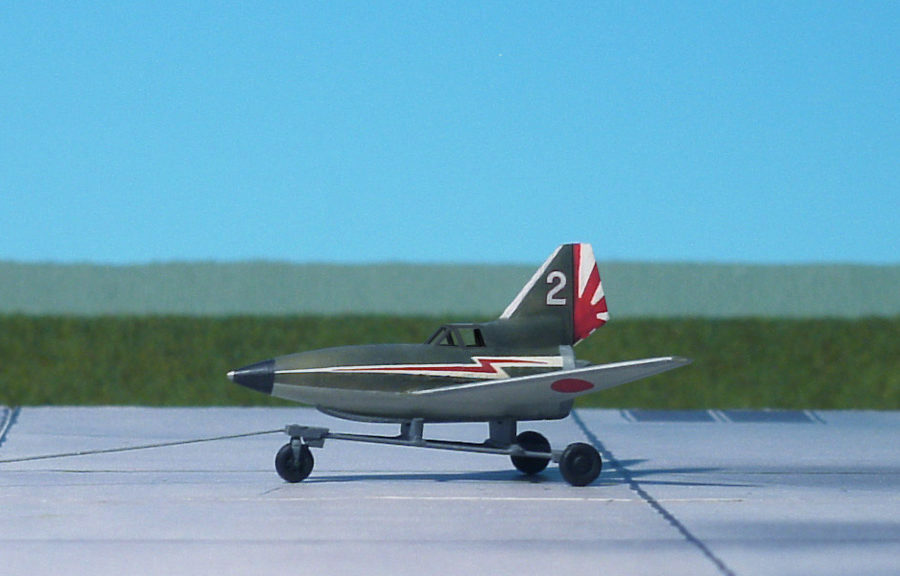TYPE: Rammer aircraft
ACCOMMODATION: Pilot only
POWER PLANT: Four Type 4 Mk. 1 Model 20 solid fuel rockets with a combined 1,102 kp thrust
PERFORMANCE: 699 mph (estimated)
COMMENT: The practice of ramming, in Japanese “tai-atari”, which literally means “body crashing”, was not unique to Japan. During WW II the deliberate ramming of one aircraft by another aircraft was performed by the Russians, Germans as well as Japanese and all made ramming a part of their war doctrine.
The Japanese would use aircraft already in operational service for ramming attacks such as that Kawasaki Ki-45 and even stripped down Kawasaki Ki-61 “Hein” fighters. It was long thought that Japan never developed a dedicated rammer aircraft of its own but this is no longer the case. Recently discovered in the archives of the Japanese National Institute for Defense Studies is just such a project.
The aircraft was a joint venture between the Imperial Japanese Army (IJA) and the Imperial Japanese Navy (IJN), something that occurred with more regularity towards the closing stage of WW II. The design was based on the “Syusuishiki Kayaku” Rocketto (“Autumn Water”-type ram attack rocket), a project started in March 1945 for an unmanned, remote controlled anti-bomber missile. The plan was to ground launch the missile, guide it remotely towards the target, engage the target via ramming, and then recover the missile (if it survived the collision) for reuse.
Design work was carried out by the Kokukyoko (the Aeronautical Bureau) and, although a mockup was completed, the war ended before finalized production plans could be completed, let alone the missile ever being tested.
The piloted version used much the same design as the missile and was a small, tailless aircraft featuring low mounted 45′ swept wings. The fuselage was bullet shaped with a large vertical stabilizer into which the cockpit was blended. Located in the back of the fuselage were four Type 4 Mark 1 Model 20 rockets, the same as those used on the Kugisho MXYT “Oka” which on such a small aircraft pushed the maximum speed to an estimated 699 mph or just over Mach 0.91. lt is unknown if the design had swept wings because the designers understood the principles in relation to overcoming compressibility problem at transonic speeds, or if the shape was chosen as a means to provide an angled cutting surface to facilitate ramming attacks, or as a drag reducing planform. The wings were strengthened to withstand the high impact forces experienced when striking the enemy bomber. Even though the rammer could rely on speed as a defense when under power, it still had to contend with the defensive armament of the B-29 and thought the pilot had some measure of armor plating and bulletproof glass to protect him. The aircraft was certainly capable of gliding back to base to be refueled and relaunched once it had conducted its attacks. Given the small size of the plane, no landing gear was fitted. As such, it is likely the underside of the fuselage was reinforced or had a skid installed. How it was to be launched is unknown – it could have been towed aloft, catapult launched or perhaps even vertically launched.
In a ram attack, typically the tail would be targeted because the loss of the tail assembly would send the bomber out of control. Striking the wings and engines was another focus of ramming attacks. Finally, the aircraft fuselage was the other key area to strike. The probable mission profile of the rammer flying from a ground base would include being positioned within very close proximity of likely bombing targets. With the short burn time of the rockets (8-10 seconds) the aircraft’s operational radius would have been very limited. After launching, as bombers came into range the pilot would attempt to ram into either the tail or wing of the target with the objective of severing it from the fuselage. If enough speed momentum remained after the initial hit, another ram attack would be made. Should the aircraft remain in flying condition and if the pilot did not elect to ram his entire plane into a target, he would return to base where the rockets would be replaced. If the bombers were still close by, he could fly another sortie. If the rammer was towed into the air, the rockets would most likely have been fired on approach and again after hitting a target. This would provide enough power to grant a second pass with sufficient speed to allow for significant damage to be inflicted on the bomber when it struck.
However, the Kokukyoko “Syusuishiki Kayaku” would remain a paper project only. It is unclear if the design was to be the definitive rammer model or simply a proposed concept (Ref.: Dyer III, Edwin M.: Japanese Secret Projects, Experimental Aircraft of the IJA and IJN 1939-1945, Midland Publishing, Hersham, U.K., 2010).




















